Reducing Soil Permeability Using Bacteria-Produced Biopolymer
Abstract
:1. Introduction
- (i)
- The biostabilisation of sandy and silty soils with XG induces the filling of the pore spaces of the soil with hydrogels, which obstruct the water flow (i.e., pore-clogging) and consequently reduce the permeability coefficient of the XG-soil mixture. This effect tends to be more significant with an increase in the XG content of the mixture [19,20,25,30,33,34]. In fact, the experimental results of Ayeldeen et al. [34] show that treatment of sand and silty soil with a content of 2% of XG leads to a reduction in the coefficient permeability to 10% of the value shown for the untreated soils.
- (ii)
- The results of the mixture of XG (0.5%–3%) with sand-bentonite are not in line with the behaviour described previously for biostabilised silty and sandy soils since a slight increase in the permeability coefficient is observed with the increase in the XG content [35]. These results highlight the effect of the finer particles (silt or clay) in the soil type in terms of the effectiveness of the treatment with biopolymers. In fact, the increase in the XG content strengthens and makes more numerous the bonds between the clay particles (ionic/electrostatic, hydrogen, and Van der Waals). This promotes the creation of more and bigger-sized aggregates of clay particles. This leads to the widening of the water flow channels and a consequent slight increase in the coefficient of permeability, within one order of magnitude [35].
- (iii)
- The experimental findings concerning the effect of the curing time on the permeability coefficient of treated soils show some contradictory results. Thus, while Khachatoorian et al. [33] show a decrease in the permeability coefficient of treated Ottawa sand (0.43–0.6 mm size sand) over 11 days of curing, the results obtained by Cabalar et al. [25] with treated Narli sand (0.075–1.0 mm size sand) do not show a clear tendency over the same range of curing time. On the other hand, for a longer curing time, most of the experimental results show an increase in the permeability coefficient with the increase in the curing time for mixtures of XG with sand and silt, which is justified by the dehydration of the XG expected over time [25,34]. Indeed, SEM images confirm the occurrence of shrinkage over time, which increases the size of the pore spaces, and consequently an increase in the soil’s permeability [34].
- (iv)
- The increase in the permeability coefficient observed over the curing time (in the long term) is more significant in treated sands than in treated silts since the finer particles of silt delay the evaporation of the water in the voids and the dehydration of the hydrogels deposited in the pore spaces [34].
- (v)
- The gas permeability also decreases after the biostabilisation with XG; indeed, a mixture of 3% xanthan gum with kaolin clay decreases the gas permeability of the mixture in relation to the untreated clay by up to two orders of magnitude [36]. This effect is more significant for a higher water content since there is more water available for the hydration of the biopolymers, which promotes a more effective pore-clogging [36].
2. Materials and Methods
2.1. Soil Characterisation
2.2. Production of the Xanthan Gum Biopolymer Compound
2.3. Commercial Xanthan Gum
2.4. Portland Cement
2.5. Testing Procedure
3. Results and Discussion
3.1. Effect of Type and Content of the Stabilising Agent
3.2. Effect of the Hydraulic Gradient
3.3. Effect of Curing Time
3.4. Analysis of the Structures Formed in the Biopolymer-Sol Mixture and Chemical Analysis
4. Conclusions
- (i)
- The treatment of the soil with both types of XG induces a significant decrease in the coefficient of permeability compared to the untreated soil.
- (ii)
- The comparison of the two types of XG shows that the LabXLG is less effective than the commercial XG, which is related to its lower level of purity. The lyophilized biomass formed by S. maltophilia Faro439 also contains lyophilized cells as well as the biopolymer.
- (iii)
- The use of a 0.33% content of commercial XG is more effective to reduce the coefficient of permeability of the treated soil than the use of 1% cement, namely for a curing time of 7 and 14 days. These results indicate that XG can replace the use of cement in the short term, for instance in temporary works.
- (iv)
- The increase in the hydraulic gradient induces a slight decrease in the permeability coefficient. This is consistent with the descendent water flow used in the permeability tests since the increase in the hydraulic gradient tends to increase the vertical effective stress with the consequent decreases in the void ratio and the soil’s permeability.
- (v)
- The treatment with both types of XG demonstrates a slight decrease in the permeability coefficient during the first 14 days of curing, followed by an increase for longer times. The initial decrease in the soil’s permeability is associated with the hydration of the hydrogels, while the increase in the soil’s permeability over time probably reflects the existence of some biodegradation of the XG and/or the eventual dehydration of the hydrogels associated with the consequent shrinkage.
- (vi)
- The microstructure of the treated soil depends on the type of XG, which is linked with each one’s effectiveness to reduce the soil’s permeability. Thus, the LabXLG creates a network of fibres that links the soil particles and decreases the voids in the soil, while the commercial XG induces the partial filling of the pore spaces with a homogeneous paste, probably due to the hydration of the hydrogels.
Author Contributions
Funding
Institutional Review Board Statement
Informed Consent Statement
Data Availability Statement
Acknowledgments
Conflicts of Interest
References
- Correia, A.A.S.; Casaleiro, P.D.F.; Rasteiro, M.G. Applying multiwall carbon nanotubes for soil stabilization. Procedia Eng. 2015, 102, 1766–1775. [Google Scholar] [CrossRef] [Green Version]
- Rapier, R. Global Carbon Dioxide Emissions-Facts and Figures. Consum. Energy Repor. 2012, 102, 1766–1775. [Google Scholar]
- Oss, H.G.V. Cement Statistics and Information; US Geological Survey: Reston, VA, USA, 2014. [Google Scholar]
- Chang, I.; Im, J.; Cho, G.C. Introduction of microbial biopolymers in soil treatment for future environmentally friendly and sustainable geotechnical engineering. Sustainability 2016, 8, 251. [Google Scholar] [CrossRef] [Green Version]
- Mendonça, A.; Morais, P.V.; Pires, A.C.; Chung, A.P.; Oliveira, P.V. A Review on the Importance of Microbial Biopolymers Such as Xanthan Gum to Improve Soil Properties. Appl. Sci. 2021, 11, 170. [Google Scholar] [CrossRef]
- Whiffin, V.S.; van Paassen, L.A.; Harkes, M.P. Microbial carbonate precipitation as a soil improvement technique. Geomicrobiol. J. 2007, 24, 417–423. [Google Scholar] [CrossRef]
- Venda Oliveira, P.J.; Costa, M.S.; Costa, J.N.P.; Nobre, M.F. Comparison of the ability of two bacteria to improve the behaviour of a sandy soil. J. Mater. Civ. Eng. 2015, 27, 06014025. [Google Scholar] [CrossRef]
- Jiang, N.J.; Soga, K. The applicability of microbially induced calcite precipitation (MICP) for internal erosion control in gravel–sand mixtures. Géotechnique 2017, 67, 42–55. [Google Scholar] [CrossRef] [Green Version]
- Venda Oliveira, P.J.; Freitas, L.D.; Carmona, J.P.S.F. Effect of Soil Type on the Enzymatic Calcium Carbonate Precipitation Process Used for Soil Improvement. J. Mater. Civ. Eng. 2016, 29, 04016263. [Google Scholar] [CrossRef]
- Venda Oliveira, P.J.; Neves, J.P.G. Effect of Organic Matter Content on Enzymatic Biocementation Process Applied to Coarse-Grained Soils. J. Mater. Civ. Eng. 2019, 31, 04019121. [Google Scholar] [CrossRef]
- Venda Oliveira, P.J.; Rosa, J.A.O. Confined and unconfined behavior of a silty sand improved by the enzymatic biocementation method. Transp. Geotech. 2020, 24, 100400. [Google Scholar] [CrossRef]
- Carmona, J.P.S.F.; Venda Oliveira, P.J.; Lemos, L.J.L.; Pedro, A.M.G. Improvement of a sandy soil by enzymatic CaCO3 precipitation. Proc. Inst. Civ. Eng.-Geotech. Eng. 2018, 171, 3–15. [Google Scholar] [CrossRef]
- Yasuhara, H.; Neupane, D.; Hayashi, K.; Okamura, M. Experiments and predictions of physical properties of sand cemented by enzymatically-induced carbonate precipitation. Soils Found. 2012, 52, 539–549. [Google Scholar] [CrossRef] [Green Version]
- Jang, J. A Review of the Application of Biopolymers on Geotechnical Engineering and the Strengthening Mechanisms between Typical Biopolymers and Soils. Adv. Mater. Sci. Eng. 2020, 2020, 1465709. [Google Scholar] [CrossRef] [Green Version]
- van Paassen, L.A.; Ghose, R.; van der Linden, T.J.M.; van der Star, W.R.L.; van Loosdrecht, M.C.M. Quantifying biomediated ground improvement by ureolysis: Large-scale biogrout experiment. J. Geotech. Geoenviron. Eng. 2010, 136, 1721–1728. [Google Scholar] [CrossRef]
- Al Qabany, A.; Soga, K. Effect of chemical treatment used in MICP on engineering properties of cemented soils. Géotechnique 2013, 63, 331–339. [Google Scholar] [CrossRef]
- Lin, H.; Suleiman, M.T.; Brown, D.G.; Kavazanjian, E., Jr. Mechanical behavior of sands treated by microbially induced carbonate precipitation. J. Geotech. Geoenviron. Eng. 2016, 142, 04015066. [Google Scholar] [CrossRef]
- Chou, C.W.; Seagren, E.A.; Aydilek, A.H.; Lai, M. Biocalcification of sand through ureolysis. J. Geotech. Geoenviron. Eng. 2011, 137, 1179–1189. [Google Scholar] [CrossRef] [Green Version]
- Venda Oliveira, P.J.; Cabral, D.J.R. Behaviour of a silty sand stabilized with xanthan gum under unconfined and confined conditions. Proc. Inst. Civ. Eng.-Ground Improv. 2021. [Google Scholar] [CrossRef]
- Dehghan, H.; Tabarsa, A.; Latifi, N.; Bagheri, Y. Use of Xanthan and guar gums in soil strengthening. Clean Technol. Environ. Policy 2019, 21, 155–165. [Google Scholar] [CrossRef]
- Chang, I.; Prasidhi, A.K.; Im, J.; Shin, H.D.; Cho, G.C. Soil treatment using microbial biopolymers for anti-desertification purposes. Geoderma 2015, 253-254, 39–47. [Google Scholar] [CrossRef]
- Chang, I.; Kwon, Y.-M.; Im, J.; Cho, G.-C. Soil consistency and interparticle characteristics of Xanthan gum biopolymer–containing soils with pore-fluid variation. Can. Geotech. J. 2019, 56, 1206–1213. [Google Scholar] [CrossRef]
- Kwon, Y.-M.; Chang, I.; Lee, M.; Cho, G.-C. Geotechnical engineering behavior of biopolymer-treated soft marine soil. Geomech. Eng. 2019, 17, 453–464. [Google Scholar]
- Lee, S.; Chung, M.; Park, H.M.; Song, K.-I.; Chang, I. Xanthan gum Biopolymer as Soil-Stabilization Binder for Road Construction Using Local Soil in Sri Lanka. J. Mater. Civ. Eng. 2019, 31, 06019012. [Google Scholar] [CrossRef]
- Cabalar, A.F.; Wiszniewski, M.; Skutnik, Z. Effects of Xanthan Gum Biopolymer on the Permeability, Odometer, Unconfined Compressive and Triaxial Shear Behavior of a Sand. Soil Mech. Found. Eng. 2017, 54, 356–361. [Google Scholar] [CrossRef]
- Antonette, J.; Donza, J.; Jaradat, K.A.; Darbari, Z.; Abdelaziz, S.L. Filler-Stabilized Xanthan Gum for Soil Improvement. In Proceedings of the Eighth International Conference on Case Histories in Geotechnical Engineering, Philadelphia, PA, USA, 24–27 March 2019. [Google Scholar] [CrossRef]
- Ayeldeen, M.; Negm, A.; El-Sawwaf, M.; Kitazume, M. Enhancing mechanical behaviors of collapsible soil using two biopolymers. J. Rock Mech. Geotech. Eng. 2017, 9, 329–339. [Google Scholar] [CrossRef]
- Chang, I.; Jeon, M.; Cho, G.C. Application of microbial biopolymers as an alternative construction binder for earth buildings in underdeveloped countries. Int. J. Polym. Sci. 2015, 2015, 326745. [Google Scholar] [CrossRef] [Green Version]
- Nugent, R.; Zhang, G.; Gambrell, R. Effect of exopolymers on the liquid limit of clays and its engineering implications. Transp. Res. Rec. 2010, 2101, 34–43. [Google Scholar] [CrossRef]
- Bouazza, A.; Gates, W.P.; Ranjith, P.G. Hydraulic conductivity of biopolymer-treated silty sand. Géotechnique 2009, 59, 71–72. [Google Scholar] [CrossRef]
- Fatehi, H.; Abtahi, S.M.; Hashemolhosseini, H.; Hejazi, S.M. A novel study on using protein based biopolymers in soil strengthening. Constr. Build. Mater. 2018, 167, 813–821. [Google Scholar] [CrossRef]
- Yong, S.K.; Shrivastava, M.; Srivastava, P.; Kunhikrishnan, A.; Bolan, N. Environmental applications of chitosan and its derivatives. Rev. Environ. Contam. Toxicol. Vol. 2015, 233, 1–43. [Google Scholar]
- Khachatoorian, R.; Petrisor, I.G.; Kwan, C.-C.; Yen, T.F. Biopolymer plugging effect: Laboratory-pressurized pumping flow studies. J. Pet. Sci. Eng. 2003, 38, 13–21. [Google Scholar] [CrossRef]
- Ayeldeen, K.M.; Abdelazim, M.N.; Mostafa, A.E.S. Evaluating the physical characteristics of biopolymer/soil mixtures. Arab. J. Geosci. 2016, 9, 371. [Google Scholar] [CrossRef]
- Biju, M.S.; Arnepalli, D.N. Effect of biopolymers on permeability of sand-bentonite mixtures. J. Rock Mech. Geotech. Eng. 2020, 12, 1093–1102. [Google Scholar] [CrossRef]
- Ng, C.W.W.; So, P.S.; Lau, S.Y.; Zhou, C.; Coo, J.L.; Ni, J.J. Influence of biopolymer on gas permeability in compacted clay at different densities and water contents. Eng. Geol. 2020, 272, 105631. [Google Scholar] [CrossRef]
- Muguda, S.; Booth, S.J.; Hughes, P.N.; Augarde, C.E.; Perlot, C.; Bruno, A.W.; Gallipoli, D. Mechanical properties of biopolymerstabilised soil-based construction materials. Géotech. Lett. 2017, 7, 309–314. [Google Scholar] [CrossRef]
- Qureshi, M.U.; Chang, I.; Al-Sadarani, K. Strength and durability characteristics of biopolymer-treated desert sand. Geomech. Eng. 2017, 12, 785–801. [Google Scholar] [CrossRef]
- Chang, I.; Im, J.; Prasidhi, A.K.; Cho, G.C. Effects of Xanthan gum biopolymer on soil strengthening. Constr. Build. Mater. 2015, 74, 65–72. [Google Scholar] [CrossRef]
- García-Ochoa, F.; Santos, V.E.; Casas, J.A.; Gómez, E. Xanthan gum: Production, recovery, and properties. Biotechnol. Adv. 2020, 18, 549–579. [Google Scholar] [CrossRef]
- ASTM D2487-17e1. Standard Practice for Classification of Soils for Engineering Purposes (Unified Soil Classification System); American Society for Testing and Materials: West Conshohocken, PA, USA, 2017. [Google Scholar]
- ASTM D698-12e2. Standard Test Methods for Laboratory Compaction Characteristics of Soil Using Standard Effort (12.400 ft-lbf/ft3 (600 kN-m/m3); American Society for Testing and Materials: West Conshohocken, PA, USA, 2012. [Google Scholar]
- Mendonça, A.C.S. Use of Microbial Biopolymer to Decrease Soil Permeability by Bioclogging. Master’s Thesis, University of Coimbra, Coimbra, Portugal, 2020. [Google Scholar]
- Carignatto, C.R.; Oliveira, K.S.; Lima, V.M.; Neto, P.O. New Culture Medium to Xanthan Production by Xanthomonas campestris pv. campestris. Indian J Microbiol. 2011, 51, 283–288. [Google Scholar] [CrossRef] [Green Version]
- Joga, J.R.; Varaprasad, B.J.S. Sustainable Improvement of Expansive Clays Using Xanthan Gum as a Biopolymer. Civ. Eng. J. 2019, 5, 1893–1903. [Google Scholar] [CrossRef]
- Pansu, M.; Gautheyrou, J. Handbook of Soil Analysis—Mineralogical, Organic and Inorganic Methods, English Version; Springer: Berlin/Heidelberg, Germany, 2006. [Google Scholar]
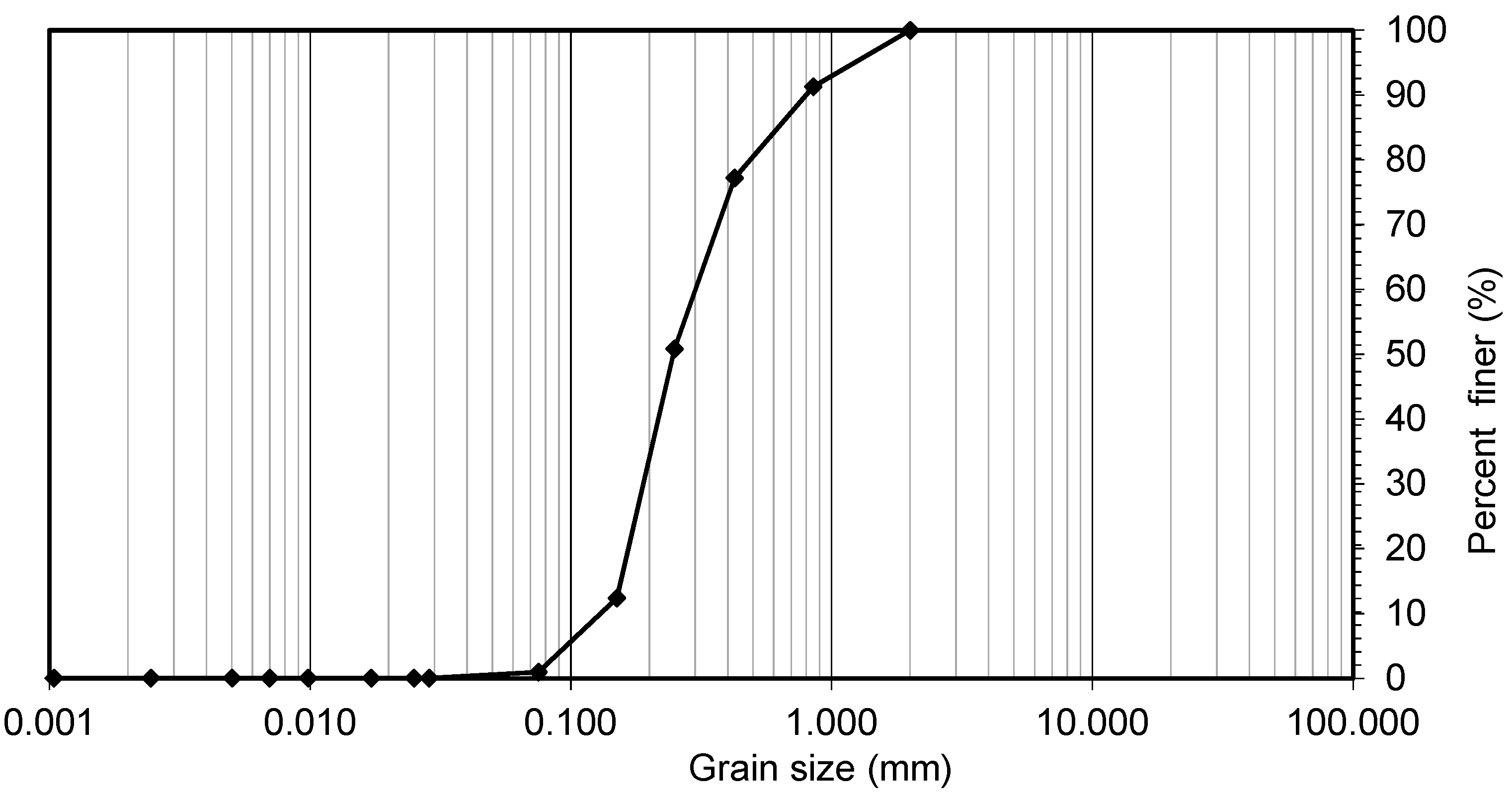
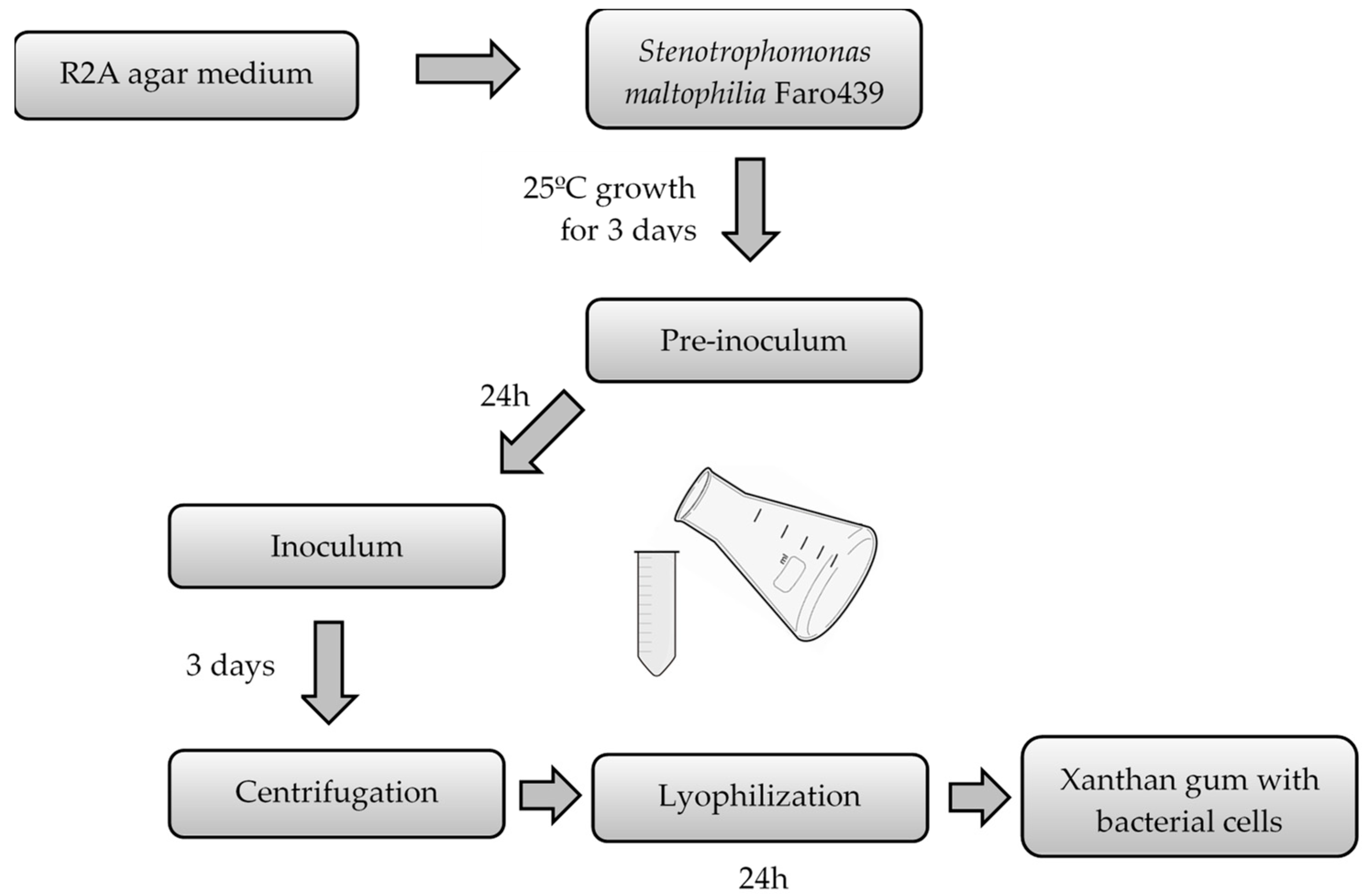
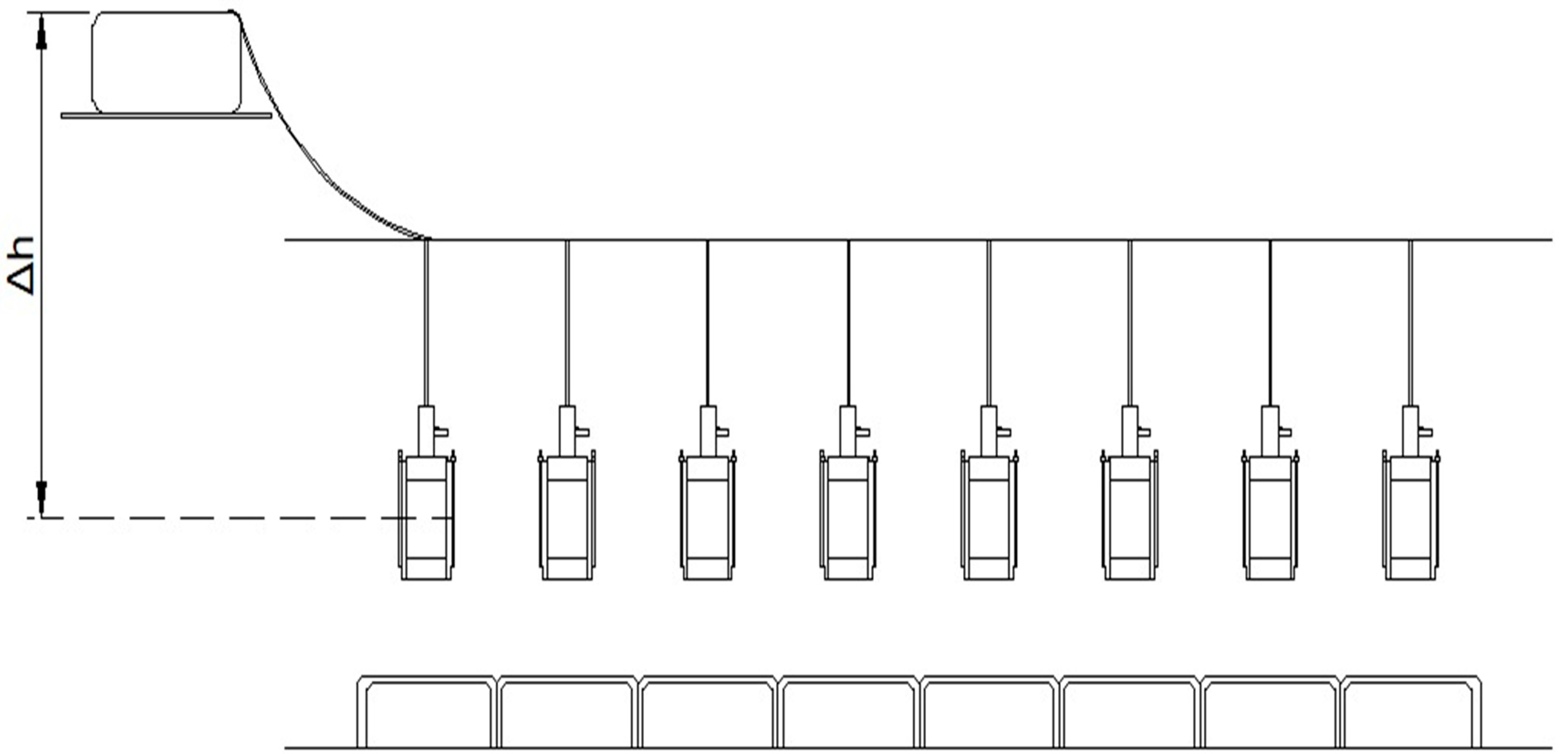

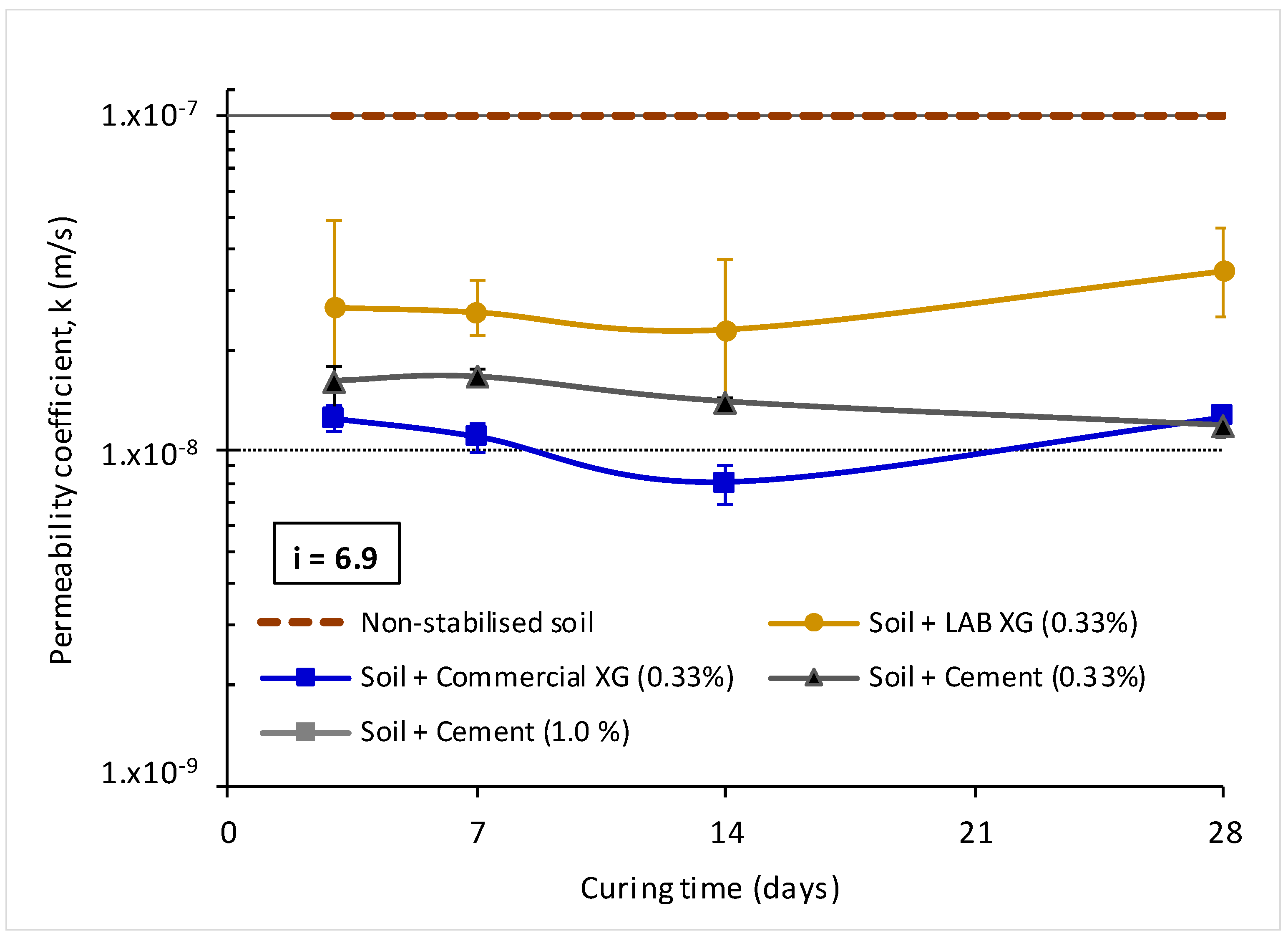
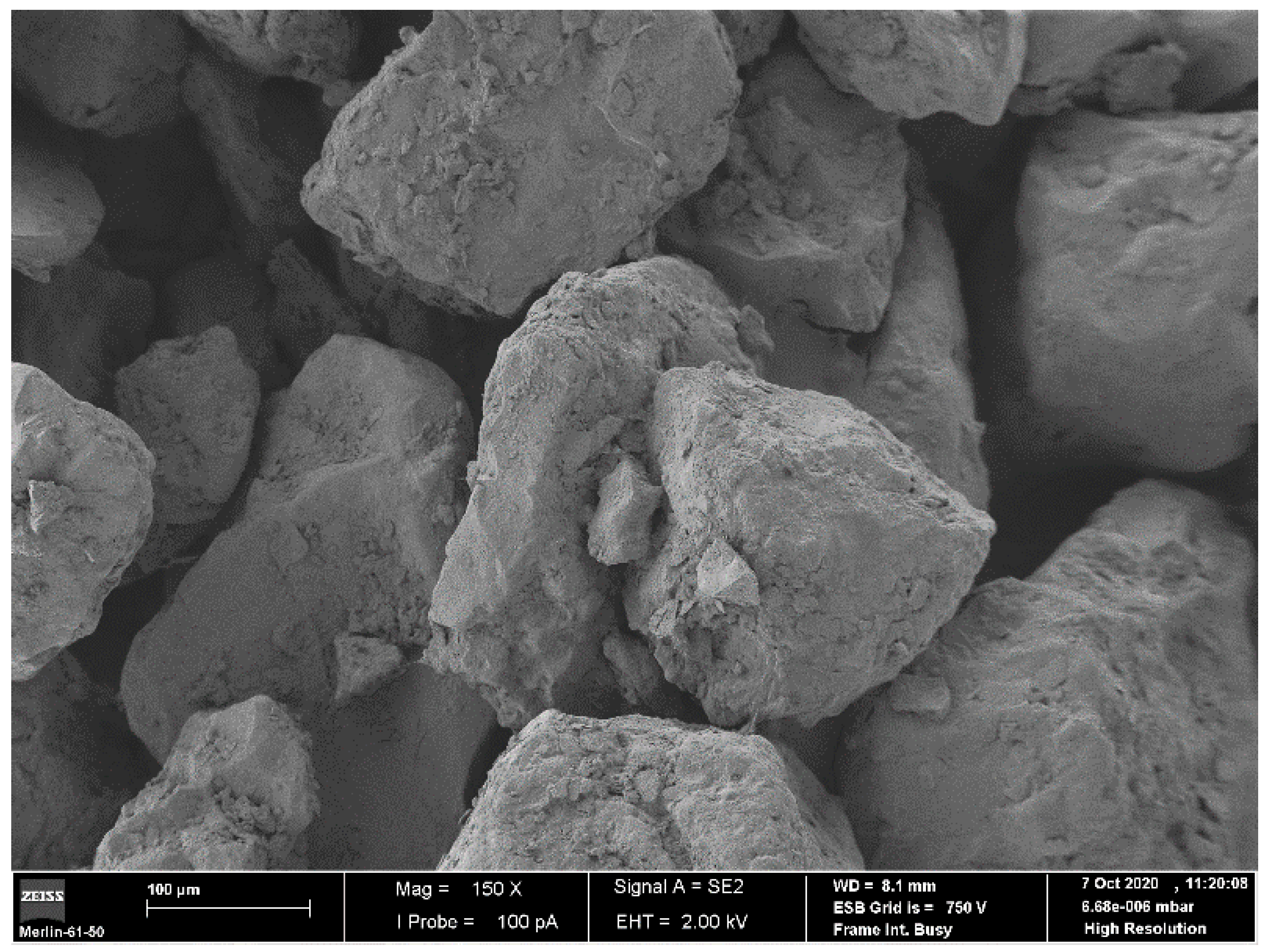
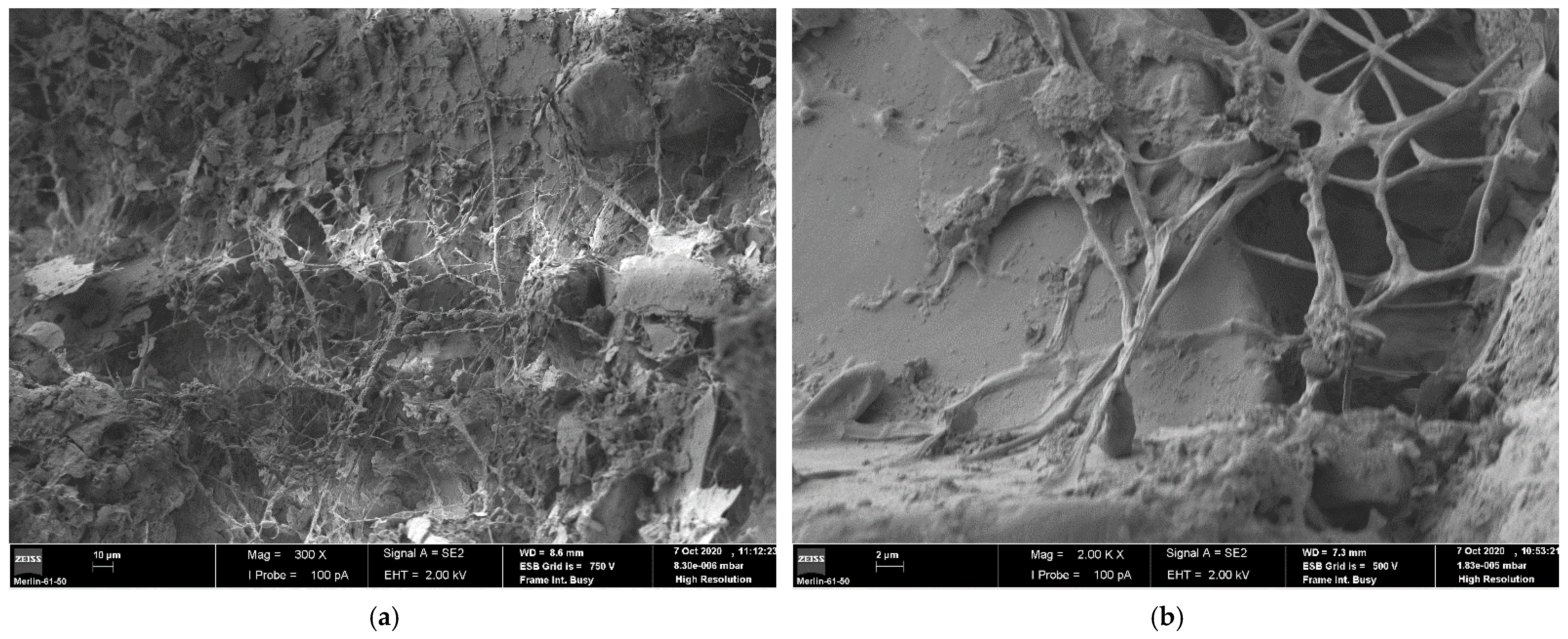


| Property | Value |
|---|---|
| Grain size distribution: | |
| Sand (%) | 72.7 |
| Silt (%) | 27.3 |
| Clay (%) | 0 |
| Specific gravity, G | 2.66 |
| Consistency limits | NP (**) |
| Standard Proctor test [ASTM D698]: | |
| Maximum dry unit weight, γdmax | 16.2 |
| Optimum water content, wopt | 14.3 |
| Organic matter content, OM (%) | 0.19 |
| pH | 7.1 |
| Soil classification, USCS (*) [ASTM D2487] | SM |
| Grout Agents | Hydraulic Gradient (m/m) | Curing Time (Days) | ||
|---|---|---|---|---|
| Lab XLG (%) (*) | Commercial XG (%) | Cement (%) | ||
| 0 (*) | 0 (*) | 0 (**) | 6.9 | -- |
| 8.2 | -- | |||
| 9.4 | -- | |||
| 10.6 | -- | |||
| -- | 0.16 | -- | 6.9 | 3/7/14/28 |
| 8.2 | 3/7/14/28 | |||
| 9.4 | 3/7/14/28 | |||
| 10.6 | 3/7/14/28 | |||
| -- | 0.33 | -- | 6.9 | 3/7/14/28 |
| 8.2 | 3/7/14/28 | |||
| 9.4 | 3/7/14/28 | |||
| 10.6 | 3/7/14/28 | |||
| 0.33 | -- | -- | 6.9 | 3/7/14/28 |
| 8.2 | 3/7/14/28 | |||
| 9.4 | 3/7/14/28 | |||
| 10.6 | 3/7/14/28 | |||
| -- | -- | 0.33 | 6.9 | 3/7/14/28 |
| 8.2 | 3/7/14/28 | |||
| 9.4 | 3/7/14/28 | |||
| 10.6 | 3/7/14/28 | |||
| -- | -- | 1.0 | 6.9 | 3/7/14/28 |
| 8.2 | 3/7/14/28 | |||
| 9.4 | 3/7/14/28 | |||
| 10.6 | 3/7/14/28 | |||
Publisher’s Note: MDPI stays neutral with regard to jurisdictional claims in published maps and institutional affiliations. |
© 2021 by the authors. Licensee MDPI, Basel, Switzerland. This article is an open access article distributed under the terms and conditions of the Creative Commons Attribution (CC BY) license (https://creativecommons.org/licenses/by/4.0/).
Share and Cite
Mendonça, A.; Morais, P.V.; Pires, A.C.; Chung, A.P.; Oliveira, P.J.V. Reducing Soil Permeability Using Bacteria-Produced Biopolymer. Appl. Sci. 2021, 11, 7278. https://doi.org/10.3390/app11167278
Mendonça A, Morais PV, Pires AC, Chung AP, Oliveira PJV. Reducing Soil Permeability Using Bacteria-Produced Biopolymer. Applied Sciences. 2021; 11(16):7278. https://doi.org/10.3390/app11167278
Chicago/Turabian StyleMendonça, Amanda, Paula V. Morais, Ana Cecília Pires, Ana Paula Chung, and Paulo J. Venda Oliveira. 2021. "Reducing Soil Permeability Using Bacteria-Produced Biopolymer" Applied Sciences 11, no. 16: 7278. https://doi.org/10.3390/app11167278
APA StyleMendonça, A., Morais, P. V., Pires, A. C., Chung, A. P., & Oliveira, P. J. V. (2021). Reducing Soil Permeability Using Bacteria-Produced Biopolymer. Applied Sciences, 11(16), 7278. https://doi.org/10.3390/app11167278









